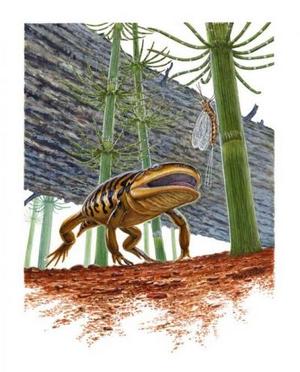The description of an ancient amphibian that millions of years ago swam in quiet pools and caught mayflies on the surrounding land in Texas has set to rest one of the greatest current controversies in vertebrate evolution. The discovery was made by a research team led by scientists at the University of Calgary.
The examination and detailed description of the fossil, Gerobatrachus hottoni (meaning Hotton's elder frog), proves the previously disputed fact that some modern amphibians, frogs and salamanders evolved from one ancient amphibian group called temnospondyls.
The discovery is described for the first time in the prestigious international research journal
Nature.
"The dispute arose because of a lack of transitional forms. This fossil seals the gap," says Jason Anderson, assistant professor, University of Calgary Faculty of Veterinary Medicine and lead scientist in the study.

|
| ©Michael Skrepnick
|
| An Early Permian landscape, with Gerobatrachus hottoni lunging at the mayfly Protoreisma between stands of Calamites and under a fallen Walchia conifer.
|
